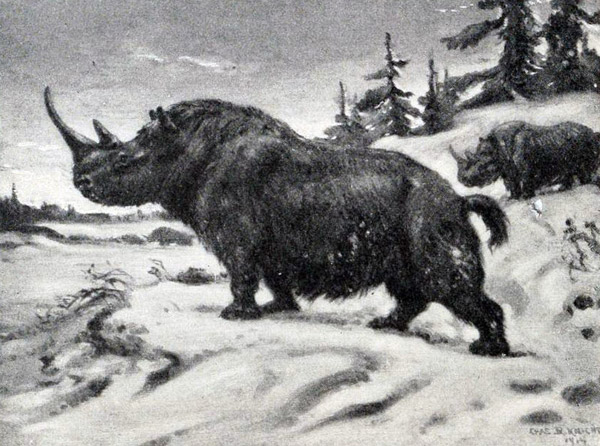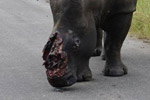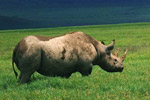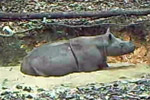Conservationists have succeeded in catching a wild Sumatran rhino in the Malaysia state of Sabah in Borneo, according to local media reports. Officials are currently transferring the rhino, an unnamed female, to a rhino sanctuary in Tabin National Park where experts will attempt to mate her with the resident male, Tam. The Sumatran rhino (Dicerorhinus sumatrensis) is one of the world’s most imperiled species with less than 100 individuals left.
“The rhino fell into a pit trap dug at a site on a known rhino trail deep inside the Danum Valley Conservation Area about six hours’ walk from Yayasan Sabah’s Borneo Rainforest Lodge,” Sen Nathan, Assistant Director and Veterinarian of Sabah Wildlife Department told the Daily Express. “It turned out to be quite an aggressive female and no report of injury on the animal had been received from the field so far.”
According to more recent media reports, the rhino is in good condition. The female is presumably an individual that conservationists have been monitoring for years and attempted to capture several times before this. They are hopeful that she will mate and reproduce with Tam. However, they have been disappointed in the past: another female, Puntung, has yet to become pregnant by Tam despite the best expertise and technology available. Given these difficulties, officials in Sabah were openly talking about moving Tam to Cincinnati Zoo—currently home to two individuals—to mate with the resident female there. However with the successful capture of a wild rhino, this may be on hold.

Tam in his semi-wild sanctuary in Tabin National Park. Photo by: Jeremy Hance.
Sumatran rhinos, which were once found from Borneo to India and Sumatra to Myanmar, were wiped out over the last century by vast deforestation and relentless poaching. Today they are only found in Malaysia and Indonesia, including Sumatra, Borneo, and peninsular Malaysia. While still imperiled by deforestation and poaching, the species’ biggest threat is that most remaining individuals are trapped in dwindling forest fragments with little chance of meeting another rhino, let alone mating. Although there may be more Sumatran rhinos surviving than Javan rhinos (current population of 58), experts believe the Sumatran is actually more at risk since their populations are scattered and in decline, while all the world’s Javan rhinos are found in a single forest where they are successfully breeding.
This dire situation has pushing conservationists to take a bold approach: catching and mating rhinos in local, semi-wild sanctuaries. To date this approach has had one major success: in 2012 a baby Sumatran rhino was born at Way Kambas Rhino Sanctuary in Sumatra, only the fourth successful rhino born in captivity in a century, the other births having occurred in Cincinnati.
Still, given how close the species is to a slow extinction, scientists are also mulling an even more ambitious plan: mixing the two surviving subspecies—one from Borneo (Dicerorhinus sumatrensis harrissoni) and the other from Sumatra and peninsular Malaysia (Dicerorhinus sumatrensis sumatrensis). A third subspecies has already vanished.
“[We] strongly recommend to act now and exchange gametes such as semen and ovocytes (and possibly individuals) between the captive populations of Sumatran rhinoceros in Sabah (Tabin), Sumatra (Way Kambas) and Cincinnati Zoo, when it is still possible,” Benoit Goossens, Director of the Danau Girang Field Centre in Malaysia, said last year. Goossens was the lead author on a paper that argued for mixing the subspecies. While experts have agreed in principle to this plan, it hasn’t occurred yet.
The Sumatran rhino is the only member of the genus, Dicerorhinus. It is the world’s smallest and hairiest rhino species, and scientists believe it may be the closest surviving relative of the woolly rhino that once roamed Europe and Asia.

Illustration of extinct woolly rhino. Illustration by: Charles R. Knight.
Related articles
Rhino with bullet in its brain and hacked off horn wanders for days before being put down

(03/05/2014) Last week, visitors in Kruger National Park came on a horrifying sight of the poaching trade: a rhino, still alive, with its horn and part of its face chopped off. The gruesome photo of the young rhino went viral and sent South African authorities scrambling. Five days after the sighting, South African National Parks (SANParks) has announced they found the rhino and put it out of its misery.
Javan rhino population jumps by over 10 percent
(03/04/2014) The Javan rhino population has increased by over ten percent from 2012 to last year, according to new figures released by Ujung Kulon National Park. Using camera traps, rangers have counted a total of 58 Javan rhinos, up from 51 in 2012. Although the species once roamed much of Southeast Asia, today it is only found in Ujung Kulon National Park in western Javan and is known as one of the most imperiled mammals on the planet.
South Africa loses nearly 150 rhinos to poachers so far this year
(02/28/2014) Since the first of the year, South Africa has lost 146 rhinos to poachers or approximately 2.5 rhinos every day. This is a slight dip from last year’s poaching rate, which hit 1,004 for the whole year or 2.75 a day. South Africa is home to more rhinos than any other country on the planet, but the populations have been hit hard by poachers in recent years seeking rhino horn.

(02/20/2014) ‘After a long conversation with the FBI I have decided to temporarily suspend my activity on this page. I want to thank all of you who have commented [on] this important issue of Black Rhino Conservation.’ – Corey Knowlton, Feb 3, 2014. This was the last post on Corey Knowlton’s Facebook page. Knowlton is the hunter who won the Dallas Safari Club auction on January 11th to kill a Critically Endangered black rhino. All the money—$350,000—will go to a fund to protect rhinos. The plan is that sometime soon—once the paperwork clears the U.S. Fish and Wildlife Service—Knowlton will go to Namibia on a “trophy hunt” (accompanied by a park service official), shoot the designated rhino, and bring the old bull’s hide back home to Texas.
Over 1,000 rhinos killed by poachers in South Africa last year
(01/17/2014) In another sign that Africa’s poaching crisis has gotten completely out of control, South Africa lost 1,004 rhinos to poachers last year. According to the numbers released today by the South African Department of Environmental Affairs, 2013 was the worst year yet for rhino poaching in the country with nearly 3 rhinos killed every day.
Trophy hunters auction off life of Critically Endangered black rhino
(01/13/2014) The Dallas Safari Club has auctioned off a permit to shoot-and-kill a Critically Endangered black rhino in Namibia for $350,000. The club says the proceeds from the auction will aid rhino conservation, but the move has upset many wildlife organizations and attracted protestors outside the closed-door auction. In fact the issue has become so contentious that the FBI is currently investigating purported death threats against the Dallas Safari Club members over the issue. Currently, less than 5,000 black rhinos survive in the wild today, a drop of 90 percent since 1960 as the species has been decimated by poaching and habitat loss.
Requiem or recovery?: the Sumatran rhino 200 years after its description

(01/08/2014) In 1893, William Bell, a surgeon in the service of the Dutch East India Company stationed in Bencoolen, Sumatra, examined the body of a dead rhinoceros. The animal, a male, was relatively small as rhinoceroses go, measuring only four feet four inches at the shoulder and eight feet five inches from its nose to the tip of its tail. Dr. Bell noted that the animal resembled a large hog and judged it to be a young individual based upon the condition of the bones and teeth.
WWF risking Sumatran rhinos by releasing camera trap images, says scientist

(10/09/2013) On October 2nd, WWF released camera trap videos of Sumatran rhinos surviving in Kalimantan, Indonesian Borneo. The conservation organization had already announced in April that they had evidence of at least one Sumatran rhino in the province, but the new images confirmed what is likely to be a small surviving population. While this is good news for an animal on the edge of extinction, Erik Meijaard, a researcher who has worked in Indonesia for over 20 years, says WWF has made a mistake publicizing the news around the world, noting ‘the last thing those rhinos need is publicity.’
Tigers, orangutans, rhinos: Sumatra’s big mammals on the edge of extinction
(06/12/2013) Karman Lubis’s body was found near where he had been working on a Sumatran rubber plantation. His head was found several days later a mile away and they still haven’t found his right hand. He had been mauled by a Sumatran tiger that has been living in Batang Gadis National Park and he was one of five people killed there by tigers in the last five years.
Rhino populations in Sumatra, Borneo should be combined to save Sumatran rhino from extinction

(05/15/2013) A new study argues for treating endangered Sumatran populations in Borneo and Sumatra as ‘a single conservation unit’, lending academic support to a controversial proposal to move wild rhinos from Malaysia to Indonesia.
Malaysia may loan Indonesia rhinos to save species from extinction

(04/30/2013) Conservationists and officials meeting last month at a rhino crisis summit in Singapore agreed to a radical plan to loan Sumatran rhinos between nations if it means saving the critically endangered species from extinction. The proposal, which could still be thwarted by red tape and political opposition, could lead Malaysia to send some of its Sumatran rhinos to semi-captive breeding facilities in Indonesia.